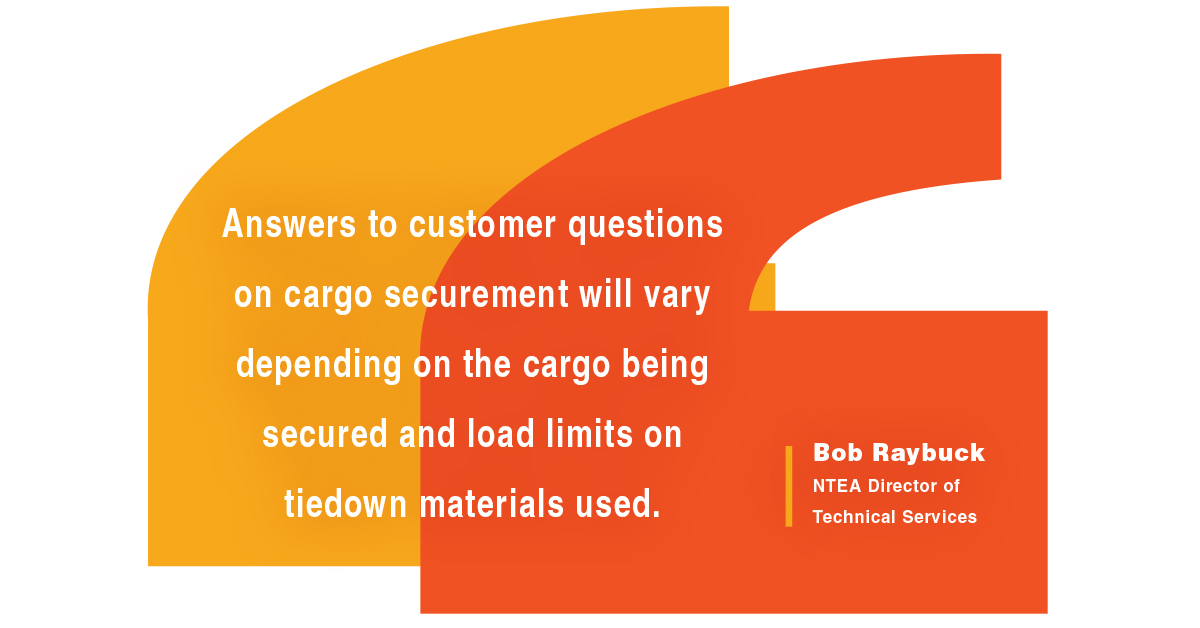Bob Raybuck
NTEA Director of Technical Services
bob@ntea.com
This article was published in the December 2021 edition of NTEA News.
From an NTEA member
Some of our truck equipment customers have recently been through motor carrier enforcement roadside inspections and have questions on cargo securement based on the inspections. Where can we find tiedown requirements to help our customers?
For background, Federal Motor Carrier Safety Administration (FMCSA) published cargo securement requirements in 49 Code of Federal Regulations (CFR) Part 393 Subpart I Protection Against Falling and Shifting Cargo. Answers to customer questions on cargo securement will vary depending on the cargo being secured and load limits on tiedown materials used.

A common misconception is rub rails are required. FMCSA published updated regulations in 2006 and 2013 to address protection of tiedown material and clarify the rub rail issue. Most notably, a requirement was removed specific to trailers equipped with rub rails by having cargo securement system components “located inboard of the rub rails whenever practicable.” While this only applied to trailers, consistent enforcement became a problem.
After many instances of misapplication, FMCSA rescinded it in the 2006 final rule. Even in the proposed rule, FMCSA specifically noted “[a]lthough Section 393.104(f)(4) was adopted to ensure that motor carriers do not expose tiedowns to potential damages if the vehicle rubs against a fixed object such as a highway barricade, this mode of failure for tiedowns appears to be extremely rare. Therefore, the Agency does not believe rescinding this paragraph would have an adverse impact on safety.”
While FMCSA withdrew this mandate, a related one was preserved in the same section, stating, “[e]dge protection must be used whenever a tiedown would be subject to abrasion or cutting at the point where it touches an article of cargo. The edge protection must resist abrasion, cutting and crushing.” Even though this specifically addresses the tiedown-cargo interface, your customers may also encounter consistent enforcement issues. Therefore, reviewing body contact surfaces where tiedowns are routed may help motor carrier customers prevent discrepancies with enforcement officials.
The requirement for a bulkhead is another potential area of confusion. If the front-end structure is used as part of cargo securement, there are specific requirements for size, strength and penetration resistance in Section 393.114. Additionally, Section 393.114 (e) Substitute Devices states: “The requirements of this section may be met by the use of devices performing the same functions as a front end structure, if the devices are at least as strong as, and provide protection against shifting articles of cargo at least equal to, a front end structure which conforms to those requirements.” For example, in some applications, this can be equipment mounted behind the cab before the payload.
There are specific securement requirements by commodity type: logs, dressed lumber and building products, metal coils, paper rolls, concrete pipe, intermodal containers, cars, trucks and vans, heavy equipment and machinery, crushed vehicles, roll-off and hooklift containers, and large boulders. Consider reviewing the securement requirements with your customer for these commodities to assure adequate tiedown capabilities are provided for the specific commodity transported.
Learn more about NTEA’s technical and engineering offerings at ntea.com/technicalresources.